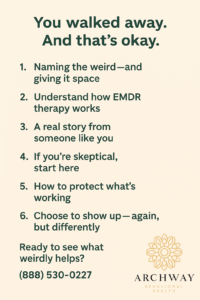You Walked Away. And That’s Okay.
Maybe halfway through IOP, you stopped responding. Maybe rehab got too scary, too demanding, or too surface-level. You didn’t fail. You were done trying what didn’t work.
You ghosted because nothing shifted. You weren’t broken. You were just unaddressed. And sometimes, what you need isn’t more tools—but a different channel.
That’s why EMDR therapy—though weird—can reach what treatment missed. It doesn’t ask you to rehash pain endlessly. It uses a different route into healing. And for many, that makes all the difference.
Step 1: Naming the Weird—and Giving It Space
EMDR therapy feels strange—eyes follow or taps rhythm while you hold a memory. It’s awkward, unfamiliar. But here’s how it helped me:
- It reached the part of my brain that talking couldn’t touch
- It nudged safety into my nervous system in ways I didn’t know I needed
- It rewrote the story I thought needed words—without me telling it
That weird is worth exploring if everything else has felt hollow.
Step 2: Understand How EMDR Therapy Works
Imagine your brain as a filing cabinet that lost its labels after trauma. EMDR therapy in Florida helps relabel those files—so memories don’t trigger panic, guilt, or shame.
Here’s the basic structure:
- Check-in & framing: On day one, you talk about how you show up—what safety feels like, what you want different.
- Identify a small target: Maybe it’s a difficult moment, emotion, or body sensation.
- Apply bilateral stimulation: You track movement or tapping while noticing the target.
- Observe the shift: A bit of calm arrives; a belief loosens; the surge behind the memory drops.
You don’t need to spill your whole story. You just hold enough to shift.
Step 3: A Real Story from Someone Like You
A peer of mine dropped out from a full 30‑day stay. She said it “felt like half-measures.” But quit the program didn’t stop her heartache.
In EMDR, she started with “I feel unsafe alone.” Soon, she traced that to a memory of being yelled at as a teen—for sharing emotions.
Two EMDR sessions later, the memory was still there—but no longer firing off nights of guilt. She slept again. She rejoined life without cringing.
Not magic. Just the brain doing what it’s meant to do—when finally given a path.
Step 4: If You’re Skeptical, Start Here
You don’t have to leap. Try this:
- Watch a short video or description of EMDR therapy
- Tell yourself: “I’ll first learn. I won’t commit.”
- Book a free consult or free-intro call
- Ask what your first session looks like
- Take one step without expectation, just openness
You control this pace. It’s ok if it feels weird. It might be exactly what finally works.
Step 5: How to Protect What’s Working
Once the calm starts slipping in, here’s what helps it stay:
- Practice grounding—like rattling your feet, squeezing your palms
- Name the shift: “I felt less tight.”
- Check in with what you used to feel—and what’s different now
- Keep your support system in the loop—friend, sponsor, sister
Growth often shows quietly. Notice it. Name it. Let it stay.
Step 6: Choose to Show Up—Again, but Differently
Skipping treatment halfway doesn’t erase how much you tried. It just means you need something else.
You’re not failing. You’re recalibrating. And sometimes that “something else” isn’t a brighter speaker or a firmer boundary. It’s a method your brain didn’t know it needed—one that reaches better than dryness or explanation ever could.
If that sounds like you—say yes to weird. It might feel awkward at first. But it also might feel like home to your nervous system when nothing else did.
Ready to See What Weirdly Helps?
Call (888) 530-0227 or visit EMDR therapy to learn more about our services in Boca Raton, Florida.
FAQ: Everything You Wanted to Know About EMDR After Dropping Out
Do I have to still be sober to do EMDR?
No. Your nervous system can begin to heal even while you’re working out other things. Therapy can support sobriety—not require it.
Is EMDR just for “big trauma”?
Not at all. EMDR is powerful for “little t” wounds too—things like constant criticism, emotional neglect, or fear that never got named.
What if it feels overwhelming?
Your clinician in Boca Raton will prioritize safety. You never have to do more than you can handle. You drop out when you feel triggered—and you come back when you feel safe again.
How long before I notice a change?
Some people feel a crack in the freeze within a session or two. Others need more time. Irregular improvements are still progress.
How do I know if EMDR is better than IOP or rehab?
EMDR isn’t inherently better. It’s different. It works when talking, routine, and structure fall short. If you’ve tried those and still feel haunted—EMDR may be the bridge you need.



